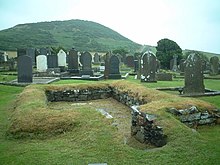Keeill
A Keeill (also Keeil; Irish: Cill) is a primitive early Christian chapel or oratory of the Iroschottischen Christians on the Isle of Man from the time before the introduction of the ecclesiastical system centered on Rome in the 12th century. The overall plan of a Keeill is reminiscent of early church enclosures in Ireland, which emerged from an older council and were certainly a model. In the 6th century a class of clergy emerged, independent of the monasteries. These hermits are known as Culdeer (from Cele De, Servants of God) and were believed to be the builders of the Keeills. However, recent analyzes suggest that construction of the keeills did not begin until the late 9th or early 10th century AD and ended in the late 13th century. The re-dating of the Keeills means that they originated within the period of Scandinavian settlement on the island. There were once over 200 keeills on the Isle of Man. The locations of around 170 are known. Today only the foundations of 35 keeills remain, giving an idea of their original appearance.
description
The oldest keeills were probably made of clay and wattle, while the ruins, dating from the 9th to 12th centuries and usually measuring five by three meters, are made of rough stones, slabs, earth and rubble. The shape is rectangular with no separation. Their size varies considerably. The Ballachrink-Keeill in Marown measures only 3.1 × 1.8 m inside. Otherwise they can be 6.9 × 4.0 (Keeill Vian, Lonan), 17.1 × 5.4 m (St Patrick's Chapel, Patrick Isle) or even 22.5 × 7.2 m (St. Trinian, Marown) to reach. The walls vary in thickness from 0.7 to 1.4 m and are protected on the outside by a dam of earth and stones 0.7 m high and 1.4 m wide. The narrow door that tapers upwards is usually located in the west gable. As a rule, the only small window is 0.6 to 0.9 m above the floor. The altar is always on the eastern wall and reaches a height of about 0.6 m. Usually keeills were built on natural or artificial elevations and had a cemetery surrounded by a rampart often over 1.5 m high. The Speke Farm Keeill stone , discovered in 2007, is one of the most unusual ogham stones found on the island .
List of the best preserved sites:
- Balladoole
- Ballafreer
- Ballaquinney
- Cabbal Dreem Ruy (Ballayelse Keeill)
- Eyreton
- Glenlough
- Lag ny Keeilley
- Maughold North and South Keeill
- Pherick a dromma
- Speke Farm
- Spooyt Vane
- Woirrey
See also
literature
- CE Lowe, P. Reilly: Keeills in a Landscape: Some New Light. In: Landscape History. 10, 1988, pp. 37-49.
- CJ Swift: Irish influence on ecclesiastical settlements in Scotland. A case study of the Island of Islay. unpublished MPhil thesis. University of Durham, 1987.
- Ray Moore: The Manx Keeill and pagan iconography: Christian and pagan responses to ideological tower in the Isle of Man during the tenth-century.



